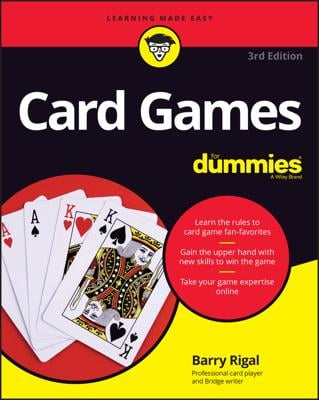Assuming you have more than one playable card, look first at the suits in which you hold end cards — the aces and kings in each suit. End cards pose all kinds of problems because you can't get rid of them until every other card in the suit has been played, usually close to the end of the game. Your strategy should revolve around persuading people to play cards in the suit in which you hold end cards. You give persuasion by playing cards in that suit, and if you have the choice of leading or playing different 7s, look at the suits with the end cards.
Choosing between 7s
Starting at the beginning of a hand, your first idea is to play as quickly as possible any 7 in a suit in which you have an end card. Similarly, if you have 2s or queens, think about playing the 7s in those suits right away. If you're playing in a four-player game and you hold back a 7 in a suit filled with end cards, you may increase your chances of not finishing last, but you reduce your chances of winning.For example, pretend that you get the cards shown here.
You want to play the 7 of spades as soon as possible to encourage others to play on the suit. You have both a high (king of spades) and a low (3 of spades) card in spades — time to get cracking on the suit at once!
With your mid-range cards in hearts, you may keep the 7 of hearts back for as long as possible, because it's to your advantage to keep players from being able to play hearts for the time being. If hearts are the last suit played, you're more likely to win the game.
Given the choice, you should start with suits in which you have end cards (aces, 2s, kings, and queens) rather than suits in which you're comfortably placed with middle cards (between the 3 and the jack).
Playing your end cards through sequences
In general, you want to minimize your opponents' opportunities to play — and thus restrict their freedom of action so they have to release cards they want to retain in their hands. Following that logic, playing an end card (an ace or a king) whenever it is legal to do so is generally a good idea. The end card gives no new opportunity for play. Make the other players release cards they're reluctant to let go, which in turn allows you to play your other cards.For the same reason that end cards are potentially attractive plays, you often find that you can use a run in your hand to force others to play. A run occurs when you hold something like the Q-J-10-9 of spades; playing the 9, 10, or jack gives no other player an additional opportunity and thus forces your opponents to make moves that they would rather not do. With any luck, those moves will help you get your end cards out.
Think carefully about whether you want to release a card in a suit to give other players opportunities to play, rather than play an end card or work on a sequence. The answer depends on whether you want your opponents to play on the suit in which you have that card in the middle of a suit, or whether you want to hold that card back to inconvenience them and make their lives more difficult. If you hold, say, a 9 and also the Q of a suit, you may want to put the 9 down quickly to encourage play on that suit. With a 9 and no card higher than it, keep the 9 for as long as you can. Why help others to play their end-cards if you don't have to?
Break out your sequences only after you've made all your plays in the suits where you have end cards.


